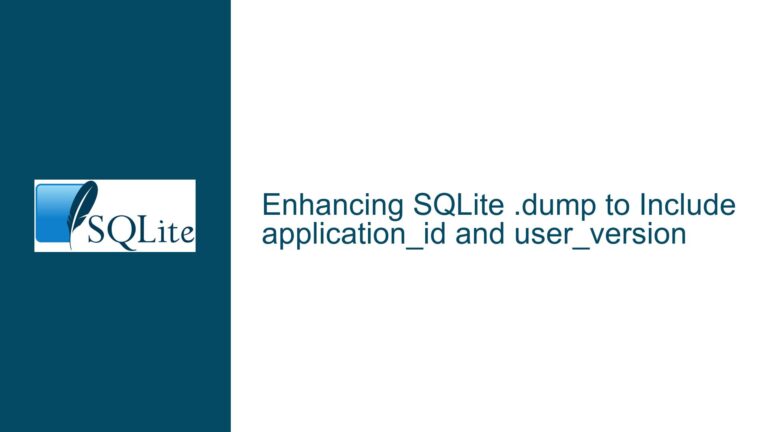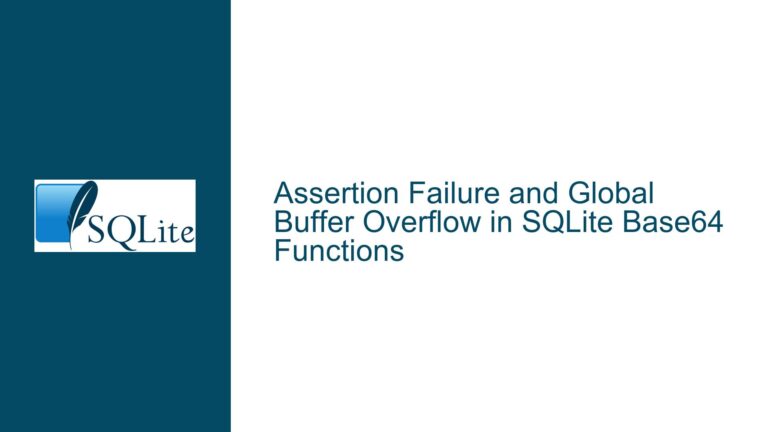Rare Corruption in SQLite WASM on OPFS: Causes and Debugging Strategies
Understanding SQLite WASM Corruption on OPFS in Chrome Extensions
The integration of SQLite WASM with the Origin Private File System (OPFS) in Chrome extensions has introduced a unique set of challenges, particularly around database corruption. This issue manifests as sporadic corruption events, often resulting in the error "SQLITE_CORRUPT: sqlite3 result code 11: database disk image is malformed." While the frequency of these events is low relative to the user base, the impact on affected users is significant, as it leads to data loss and requires manual intervention to restore functionality. The corruption appears to be environment-specific, with a strong correlation to Windows operating systems and certain user behaviors, such as abrupt system restarts while Chrome is running. This section delves into the technical underpinnings of the issue, exploring the interplay between SQLite WASM, OPFS, and the Chrome runtime environment.
SQLite WASM operates within the constraints of the browser’s JavaScript runtime, leveraging OPFS for persistent storage. OPFS, while providing a file system-like abstraction, is fundamentally different from traditional file systems. It operates entirely within the browser’s sandbox, with no direct access to the underlying hardware or kernel-level file system operations. This abstraction introduces several layers of indirection, each of which can potentially contribute to data integrity issues. For instance, the asynchronous nature of JavaScript and the event-driven architecture of browsers can lead to race conditions or incomplete writes, especially during unexpected shutdowns or crashes.
The corruption events reported by users often occur under specific conditions, such as when the system is restarted while Chrome is still running. This suggests that the issue may be related to the way OPFS handles file system operations during abrupt termination. Unlike traditional file systems, which can rely on kernel-level mechanisms to ensure data integrity during crashes, OPFS must rely on the browser’s internal mechanisms, which may not be as robust. Additionally, third-party applications like CCleaner, which interfere with browser cache and storage, can exacerbate the problem by prematurely deleting or corrupting OPFS data.
To further complicate matters, the SQLite WASM implementation introduces its own set of challenges. The WASM environment, while powerful, is still relatively new and may have undiscovered edge cases or limitations. For example, the interaction between the WASM heap and the JavaScript runtime can sometimes lead to subtle bugs, especially when dealing with large datasets or complex queries. The use of virtual tables, such as FTS5, adds another layer of complexity, as these tables require careful management of their internal state and storage.
In summary, the corruption issue in SQLite WASM on OPFS is a multifaceted problem that arises from the interaction of several factors, including the limitations of OPFS, the asynchronous nature of JavaScript, and the unique challenges of the WASM environment. Understanding these factors is crucial for developing effective debugging strategies and potential solutions.
Potential Causes of SQLite WASM Corruption on OPFS
The corruption issues observed in SQLite WASM on OPFS can be attributed to a combination of technical and environmental factors. These factors range from the inherent limitations of the OPFS abstraction to specific behaviors of the Chrome browser and third-party applications. This section explores these potential causes in detail, providing a comprehensive overview of the challenges involved.
One of the primary causes of corruption is the abrupt termination of the Chrome browser or the underlying operating system. When a user restarts their system without properly closing Chrome, the OPFS may not have sufficient time to complete pending write operations or flush its internal buffers. This can result in incomplete or inconsistent data being written to the database file, leading to corruption. The issue is particularly pronounced on Windows systems, where the file system and process management mechanisms may differ from those on other platforms. For example, Windows’ handling of file locks and process termination can sometimes lead to resource contention or incomplete cleanup, further increasing the risk of corruption.
Another potential cause is the interaction between SQLite WASM and third-party applications like CCleaner. These applications often perform aggressive cleanup of browser caches and temporary files, which can inadvertently delete or corrupt OPFS data. In the case of CCleaner, the "Internet Cache" option is known to interfere with OPFS, leading to data loss. While users can mitigate this issue by unchecking the option, the underlying problem highlights the fragility of the OPFS abstraction in the face of external interference.
The asynchronous nature of JavaScript and the event-driven architecture of browsers also play a significant role in the corruption issue. SQLite WASM relies on the browser’s event loop to handle database operations, which can lead to race conditions or incomplete writes if not managed carefully. For example, if a user attempts to access the database while a background administrative query is still running, they may encounter a "SQLITE_BUSY" error. While this behavior is expected, it underscores the challenges of managing concurrency in a single-threaded environment like JavaScript.
Additionally, the use of virtual tables, such as FTS5, introduces another layer of complexity. These tables require careful management of their internal state and storage, and any inconsistencies can lead to corruption. The interaction between virtual tables and the underlying OPFS storage may not be fully understood, especially in the context of abrupt termination or external interference.
Finally, the WASM environment itself may have undiscovered edge cases or limitations that contribute to the corruption issue. For example, the interaction between the WASM heap and the JavaScript runtime can sometimes lead to subtle bugs, especially when dealing with large datasets or complex queries. While no specific bugs have been identified in the SQLite WASM implementation, the possibility of heap corruption or other low-level issues cannot be ruled out.
In summary, the corruption issue in SQLite WASM on OPFS is likely caused by a combination of factors, including abrupt termination, third-party interference, the asynchronous nature of JavaScript, the complexity of virtual tables, and potential limitations of the WASM environment. Understanding these causes is essential for developing effective debugging strategies and potential solutions.
Debugging and Resolving SQLite WASM Corruption on OPFS
Addressing the corruption issue in SQLite WASM on OPFS requires a multifaceted approach that combines careful debugging, user education, and potential changes to the underlying implementation. This section outlines a series of steps and strategies for identifying and resolving the root causes of corruption, as well as mitigating its impact on users.
The first step in debugging the issue is to gather detailed logs from affected users. This can be achieved by implementing a custom VFS shim that logs all OPFS operations, including file reads, writes, and deletions. While this approach introduces additional complexity and potential overhead, it can provide valuable insights into the sequence of events leading to corruption. Users who can reliably reproduce the issue can be provided with a special build of the extension that includes the logging shim, allowing developers to analyze the logs and identify patterns or anomalies.
In addition to logging, developers should consider implementing robust error handling and recovery mechanisms in their extensions. For example, the extension could periodically checkpoint the database and create backups, which can be used to restore data in the event of corruption. This approach not only mitigates the impact of corruption but also provides a safety net for users who may not have access to external backups.
Another important strategy is to educate users about the potential risks of abrupt termination and third-party interference. For example, users can be advised to close Chrome before restarting their system and to avoid using applications like CCleaner that may interfere with OPFS. While this approach relies on user cooperation, it can significantly reduce the likelihood of corruption.
From a technical perspective, developers should carefully review their use of virtual tables and other advanced SQLite features. For example, the use of FTS5 virtual tables should be accompanied by thorough testing and validation to ensure that their internal state and storage are managed correctly. Additionally, developers should consider using the SQLite Write-Ahead Logging (WAL) mode, which can improve concurrency and reduce the risk of corruption during abrupt termination.
Finally, developers should stay informed about updates and improvements to the SQLite WASM implementation and the OPFS specification. As these technologies evolve, new features and bug fixes may become available that address the underlying causes of corruption. By staying up-to-date with the latest developments, developers can ensure that their extensions remain robust and reliable.
In summary, debugging and resolving the corruption issue in SQLite WASM on OPFS requires a combination of detailed logging, robust error handling, user education, careful use of advanced SQLite features, and staying informed about updates to the underlying technologies. By taking a proactive and comprehensive approach, developers can mitigate the impact of corruption and provide a more reliable experience for their users.





